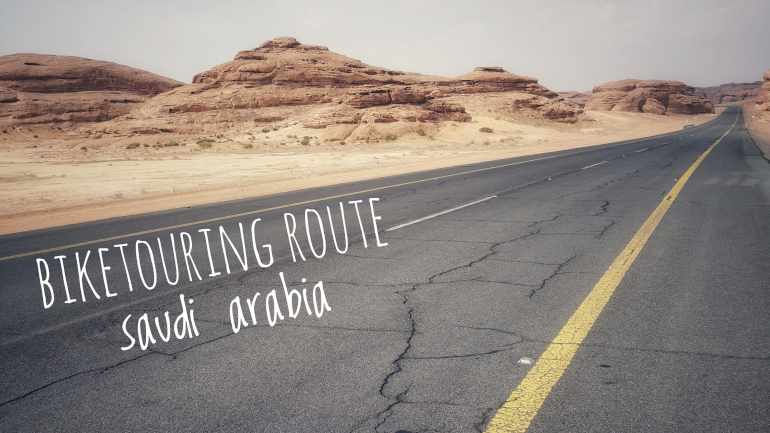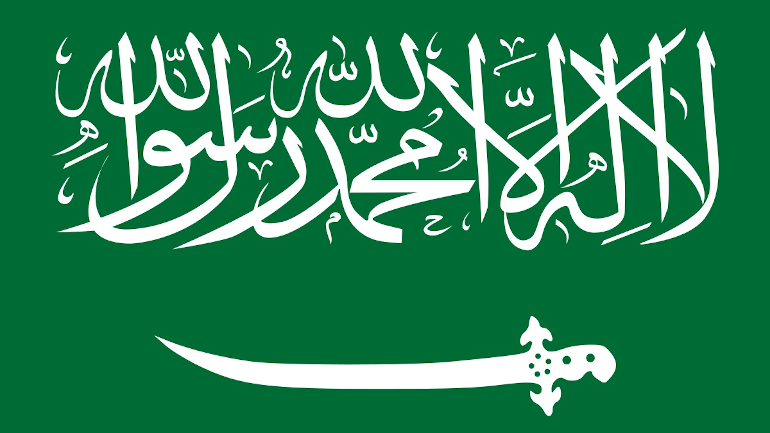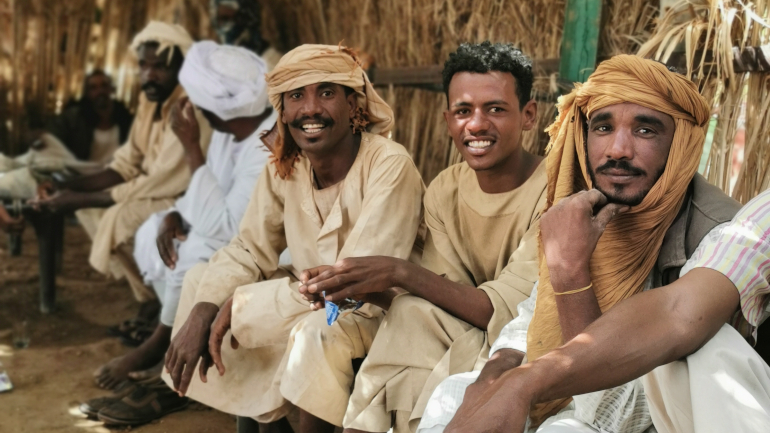Contents [hide]
Intro
Saudi Arabia is more or less just one big desert and you might think of it as the land of sand. The prospect of biking thousands of kilometers across this vast and seemingly monotonous landscape might sound bleak. But there is beauty to be found. Think deep and rich orange nuances like you have never seen before and Bedus that walk their camel caravans across the hypnotic sand dunes. Think stunning wadis in the mountain regions and kind, hospital, generous local Arabs who welcome you with open arms. This is a golden opportunity to get closer to real Arab culture which for so long has been closed to tourists.
Yes, there are long and boring stretches on the highway with strong winds that can test your patience. Sand and dust on windy days will cover you all over and your biggest wish is for a pool of refreshing water that is nowhere to be found. Yet these are small obstacles on an unforgettable journey through the birthplace of Islam.
I’ll share my experiences on the route I took. From the Rub’ al Khali border with Oman to Riyadh including a spectacular but challenging crossing of the Empty Quarter. From Riyadh to Ha’il where I started my journey down to the Red Sea stopping on my way in the historical Al Ula, which is the twin city of the famous Petra in Jordan. From Al Ula to the ending point in Duba where I took the ferry to Egypt.
DISCLAIMER: Saudi Arabia is a big country. If you decide to bike the entire country you will sooner or later find yourself on long and boring highways that seem to go on forever. All up to you if you want to bike it all but if I were to cycle the route again I would strongly consider taking car transport from Al Batha to Riyadh (section 2). From Riyadh to Ha’il (section 3) there will be some beautiful elements but they are not worth all the kilometers in my opinion so I would consider taking car transport here as well.
Get the GPX files here:
Route stats
- Distance (km): 2.334
- Total ascent (m): 6.770
- Road days: 31
- Highest point (m): 1.280
- Time of year (month): February and March
- Navigation app used: Mapy.cz
Highlights
My favorite highlights from Saudi Arabia. Consider visiting these on your tour across the Kingdom.
- Cycling along the magical sand dune landscape of the Empty Quarter
- Camping at the edge of the Al Hatima Crater
- Route 70 from Ha’il to Al Ula
- Exploring Wadi Disah
Map
Section 1: Rub’ al Khali Border Crossing (Oman) to Al Batha (Saudi Arabia)
- Route: Rub’ al Khali Border Crossing (Oman) to Al Batha (Saudi Arabia)
- Distance (km): 558
- Elevation (m): 1.565
- Days: 7
At the Rub’ al Khali border crossing between Oman and Saudi Arabia, you already start to feel that you are in no man’s land. Ahead of you, the sand dunes are rising up and signaling the beginning of the Saudi Arabian part of the Empty Quarter. This section is challening due to the lack of options to resupply water and food. I have made a detailed guide to help you plan your biketour across this ocean of sand. Check it out here.
There are two gas stations on your way until you reach the intersection road to Al Batha going east and Riyadh going west. The first one marks the halfway point. Until this gas station you have 280 km of hilly landscapes with high and stunningly beautiful sand dunes.
From the halfway point until the second gas station there is 200 km. The landscape here flattens out and you don’t see the sand dunes any more. Instead you’ll have endless flat plains that merge with the sky in the horizon. The color of the sand turns to a more bright yellow. This area is prone to strong winds. From the second gas station to the intersection road, there is a further 100 km of similar landscape on very straight roads.
The entire section has good quality asphalt with a wide shoulder which makes biking here very easy. All the elevation meters you will do are on mellow slopes with a maximum gradient of 7%. However, shade is a rare commodity and you will have to look long to find any. Sun and sand protection is key.
Section 2: Al Batha to Riyadh
- Route: Al Batha to Riyadh
- Distance (km): 649
- Elevation (m): 1.515
- Days: 6
After you hit the intersection road leading to Al Batha you are happy to see a gas station with a row of restaurants and a larger supermarket. There is also a rather expensive motel nearby if you want to wash off the sand and salt from your skin after a week’s biking in the Empty Quarter. I took a detour on my way to Salwa heading east towards Al Batha to catch highway 95 at the very beginning. There is a mega park located next to the ocean and I dearly wanted to catch some glimpses of water again and camp in a place without any sand. The mega park is located in the middle of nowhere so it is very quiet and undisturbed.
After the Empty Quarter the magic of the sand landscape fades a bit away especially when you are biking on busy highways. This continues all the way to Salwa and onwards to Hofuf in Al Hasa. The only good thing about these highways are the wide shoulder. The landscape is boring and the highlights are the Pakistani gas station restaurants that serve surprisingly delicious food. In Salwa there is a nice park as well with pavilions where you can pitch your tent to spend the night. Once you reach Al Hasa, you can take a full day’s break to explore Al Qarah Mountain.
From Al Hasa you have another stretch of long highways. There are two options. Highway 40 passes Judah where you can see an amazing rock formation called Judah Thumb. An alternative is to take road 522. Due to strong headwinds, I gave up reaching Judah and headed towards Riyadh on road 522. The road is only interesting at the very end where sand dunes appear with the chance to see camel caravans walk in between the dunes. From Al Hasa and all the way to Riyadh, I had a police escort that followed my 24 hours a day. At the beginning each new car that followed me asked for ID card and paper statement that I didn’t have. I kept showing my eVisa on my phone and after a phone call to their superior at HQ, I was good to continue. They drove behind me in the emergency lane and parked outside my tent at night. If you are not used to a constant police presence, this might feel awkward and imposing. However, it’s for our protection and I do really think you should embrace this as VIP treatment.
Once you get onto the Riyadh-Dammam highway 40 and close in on Riyadh, brace yourself for some urban mayhem. This road is not at all fun to say the least. I saw a couple of minor accidents happening and the area around the highway is all industry kicking up some nasty dust. If you ever hitch a ride, this is the place to do it. I biked into Riyadh myself and I was very very happy to have a police escort that cleared the road for me and stopped the traffic on merging lanes. Without the police car helping me out, this might have been one of the most stressful roads I have ever biked. Consider this road into, across and out of Riyadh as pure transport and I would again urge you to do this stretch in a pickup with your bike taking a well deserved rest.
I didn’t explore Riyadh at all. It’s a very big city and hard to explore on foot and biking around town is difficult. For me this was only a place to rest up and do some admin days. There are some great Warmshover hosts in the city and you can find dorms on Hostelworld that seem like good value for money.
Section 3: Riyadh to Ha’il
- Route: Riyadh to Ha’il
- Distance (km): 714
- Elevation (m): 2.150
- Days: 7
Leaving Riyadh might just be less hectic than entering the city as you can leave early and avoid rush hour in the late afternoon. The Edge of the World is a nature attraction close to Riyadh. Heading for Ha’il you should go via Sudus towards Shaqra to catch the dirt road leading to the viewpoint. As an alternative, take route 505 to Shaqra to get a view of the vertical drops of the mountain that make up The Edge of the World from a distance. I took route 505 and this view was not as spectacular as I had hoped for so I would recommend going for the actual viewpoint via Sudus - but at least route 505 has good quality asphalt and a wide shoulder. A police escort followed me out of Riyadh and half-way to Shaqra. The flat plains to Shaqra were surprisingly green and lots of Bedu tents were spread around the landscape. However, the middle part between Riyadh and Shaqra is cluttered with electrical wire towers which makes for a boring view. Just before reaching Shaqra there are some beautiful sand dunes.
From Shaqra to Unaizah you continue on route 505 which deteriorates in quality after Shaqra and there are the infamous cracks in the road every 5 meters or so making for a bumpy ride. Landscape is still very flat and you have endless views of the plains. Make sure to go via Umm Hazm to Al Mithnab to see the towering high sand dunes where there are dune buggy competitions once in a while (my navigation apps will not let me plan a route for this road as it turns into a one-way street somewhere in the middle but it is all fine to bike). There are lots of camels alongside the road but not many options for groceries. Only a couple of gas stations so plan ahead bringing enough water and food.
After Unaizah you can take one long stretch of highway to Ha’il. First part is boring urban riding and after this the highway offers a wide shoulder and the asphalt is in good quality for most parts. I followed route 65 from Unaizah to Ash Shinan to shorten the distance to Ha’il but it might be more scenic to follow the backroads. Route 65 is mostly fenced off so finding a wild camp spot is not easy. There are only a few gaps in the fence and I ended up pitching a tent up against the fence some 50 meters away from the highway. Scenery is boring until Ash Shinan so for me this part was only a transport stretch.
Some 85 km from Ha’il there is a little village called Ash Shinan. Here I left the highway to take the backroads in between an area with mountains. Go via Tabah and I highly recommend visiting the Al Hatima Crater which can be reached following a 7 km long dirt road from Tabah. Part of the dirt road is loose gravel and sand so it might require a bit of pushing your bike depending on setup. Just after Tabah you’ll pass some stunning mountain scenery before entering the flat plains leading back onto the Ha’il main road. In the area west of Ha’il you have some amazing mountains and wadis to explore if you have the time.
BONUS INFO: If you search for campground in Google Maps or better still ask some locals while in the area of Ha’il, you’ll get a lot of hits. These are not actual campgrounds but the Saudi Arabian answer to a rest-stop for travelers. Look for the ones with a Bedu tent and go for a refreshing snack of dates with tea. If you ask nicely, they might let you camp at their property.
Section 4: Ha’il to Al Ula
- Route: Ha’il to Al Ula
- Distance (km): 413
- Elevation (m): 1.540
- Days: 5
Be sure to visit one of the wadis next to Ha’il before leaving the area. Here, I had one of the most picturesque wild camping locations of my entire trip in Saudi Arabia. Leaving Ha’il is stressful. Cars here use the shoulder when there is one. So take care. You follow route 70 all the way between Ha’il and Al Ula. After the turn off to Medina on route 389, things get a lot better. Traffic gets less busy. Mountains start to dominate the landscape. Green plains with mountains in the far distance where sand crawls up the side of the rock in an attempt to swallow the entire mountain. It looks impressive and amazing. All around there is open landscape and no more fenced off roads. This is wild camp paradise if you venture a bit off the road. The roads are in good shape with a wide shoulder all the way to Al Ula but often with bumpy cracks.
The route from Ha’il to Al Ula was one of my highlights of my Saudi Arabian tour. It’s located on an elevated plateau and you are +1000 meters above sea level which makes temperatures here more manageable in the summer shoulder months. Be aware of sandstorms as they do occur in the area. Check the weather forecast and always anchor your tent in solid ground. Winds can pick up in an instant. The route is also sparsely populated and you will not pass many gas stations and grocery stores. I was able to fill my water bottles once a day and get some basic canned foods from the grocery stores. Put a mark in your map of the gas stations and grocery stores along the route so you know where to get supplies.
The ultimately best part of route 70 is the last 100 km before you reach Al Ula. Here you’ll see the magical mushroom mountains (my own term). They are round and curvy and pop straight out of the sand. Although they are a bit hard to explore on a bike due to the loose sand surface you can look after 4WD tracks and bike on these with a bit of luck. Taking some time here is recommended and it’s a perfect spot to pitch your tent and spend the night.
Section 5: Al Ula to Duba
- Route: Al Ula to Duba
- Distance (km): 466
- Elevation (m): 2.850
- Days: 6
Al Ula is one the more touristy cities of Saudi Arabia and for a good reason. Here, you will find the twin city of Petra (Jordan) called Hegra or Mada’in Salih. You can also visit the largest mirror building in the world and explore a stunning viewpoint of the city at Harrat and spend the evening at cafés in the old town of Al Ula. If you are up for stargazing, pick the right time of month and go to Al Buriekah (it’s 100 km north of Al Ula so if this is not on your path you might want to take a car transport there).
From Al Ula I took route 8776 to Bada and then onwards to Ad Disah. There are signs here saying no trucks allowed but that is not true. There are mainly trucks on the road but not many. You will have a wide shoulder and smooth asphalt with no cracks. Scenery is with many higher mountains with a more blackish color than the ones you see in Al Ula. There are some hills to pass but none with a higher gradient than 7%. Still amazing though and a road worth taking.
Once you are closing in on Ad Disah you are in for a treat. This little village marks the beginning of Wadi Disah which probably is the most beautiful wadi in Saudi Arabia. Spending a couple of days in my tent in Wadi Disah was one of my highlights. Nearly vertical reddish rock towers shoot up from the ground. Palm trees and green vegetation fills the wadi floor and you have a myriad of bird sounds all around you. It’s a bit tricky to explore the wadi on a bike due to the sandy surface but it’s possible with a bit of patience. You can also take a 4WD tour but these are very expensive (250 SAR for an hour). It’s easy to walk the distance in some hours so perhaps this is the best option.
From Ad Disah you will lose the shoulder taking the back roads to Duba going straight west to route 55 (skipping the connection with route 80). The amazing scenery fades and I was not very impressed by the roads from Ad Disah to Duba. And Duba itself is an anti climax. It’s a rundown port city and I had no luck finding any hotel rooms here as they often are rented out to larger corporations and businesses. I slept in Duba’s city park on my last night in Saudi Arabia before heading for the ferry to Egypt.
ATTENTION: The road north of Duba to the ferry terminal has no shoulder. Although it’s a double lane road in each direction, vehicles drive with no risk attention and with no care about your well being as a cyclist. It is as if they don’t care if they hurt or kill you. So take extra care and consider taking a car transport.
planning and travel toolkit saudi arabia
2023-03-15 | toolkit
A practical biketouring guide for Saudi Arabia giving you info on visa, border crossings, SIM card, budget, wild camping, ATM, dresscode, when to travel
and more
biketouring sudan
2023-04-17 | blog
Biketouring blog covering the story of a demanding recovery both physically and mentally from a big crash and how I escaped after being caught in a war between the Rapid Support Forces and the Sudanese Military



